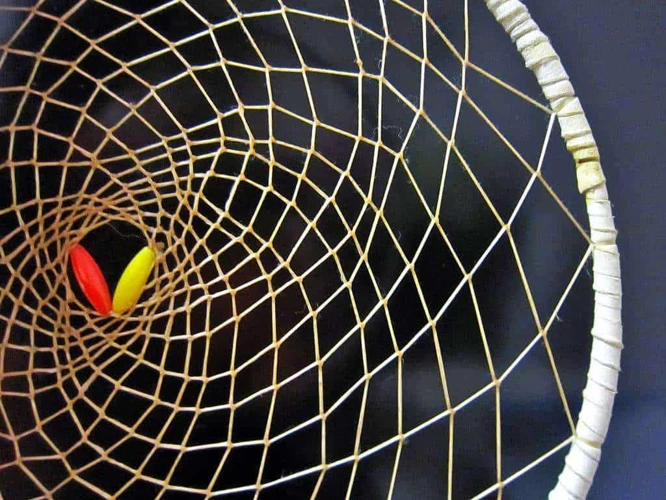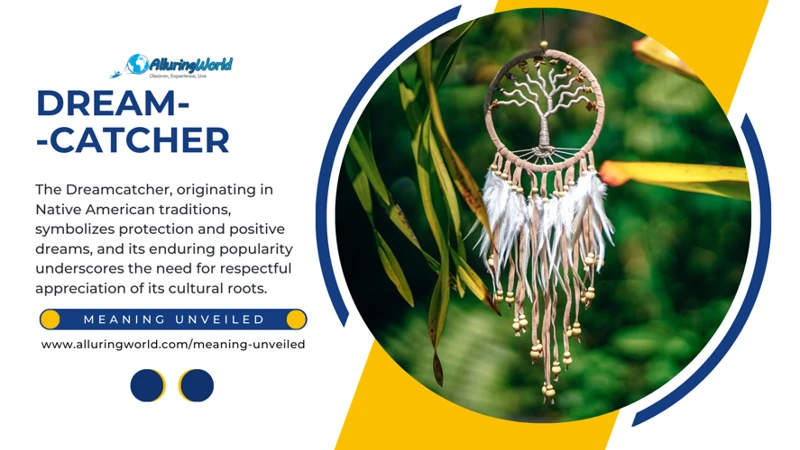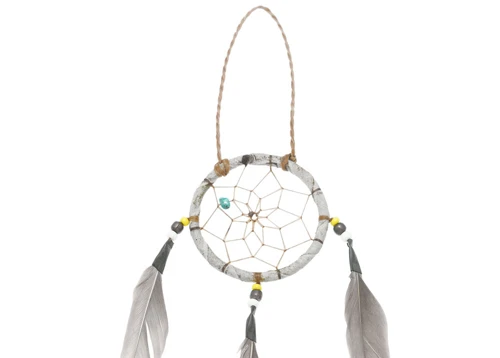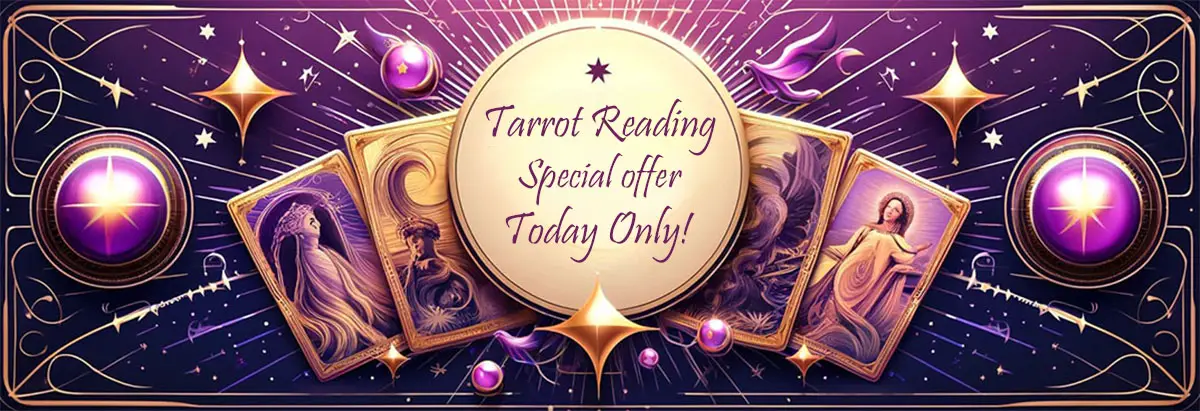The enchanting meaning behind dream catchers has captured the curiosity and fascination of people worldwide. These intricate and beautiful objects have a rich history and cultural significance that dates back centuries. From the beliefs of Native American tribes to the legends of the Spider Woman, the origins of dream catchers are shrouded in mystery. But what exactly do these enchanting creations symbolize? And how can they be used to enhance our lives? In this comprehensive guide, we will delve into the history, design, symbolism, and usage of dream catchers, offering a step-by-step exploration of their meaning and significance. Whether you are a believer in the mystical or simply drawn to their aesthetic appeal, this article will provide you with the knowledge and understanding to appreciate the enchanting world of dream catchers.
History and Origins of Dream Catchers

The history and origins of dream catchers are deeply intertwined with Native American beliefs and legends. The symbolic objects have their roots in the customs and traditions of various tribes across North America. The precise origin of dream catchers remains a topic of debate among scholars, but it is widely believed that they originated with the Ojibwe or Chippewa people. Native Americans have long believed in the power of dreams and their connection to the spiritual realm. According to their beliefs, dream catchers were created to protect individuals from negative spirits and nightmares, while allowing positive dreams to pass through. One /what-is-the-meaning-of-dream-catcher/ interesting legend associated with dream catchers is the tale of the Spider Woman, who is said to have taught the Ojibwe people how to weave spider webs into intricate circles. These circles, adorned with feathers and other sacred objects, were thought to capture and filter dreams, ensuring protection and guidance for those who slept beneath them.
1. Native American Beliefs
Native American tribes hold deep spiritual beliefs regarding dream catchers. These sacred objects are believed to have the power to filter dreams, allowing only positive ones to pass through while catching and trapping negative dreams. The Ojibwe people, for example, believe that when a dream catcher is hung above a sleeping individual, it acts as a protective talisman that shields them from evil spirits and nightmares. The circular shape of the dream catcher represents the circle of life and the interconnectedness of all living beings. Each component of the dream catcher holds its own significance, from the /what-is-a-dream-catchers-meaning/ willow hoop that represents the circle of life to the intricately woven web that captures dreams. The feathers attached to the dream catcher symbolize the breath of life and act as a conduit to carry positive dreams down to the dreamer. These beliefs and customs highlight the profound spiritual and cultural significance of dream catchers in Native American traditions.
2. Legend of the Spider Woman
According to the enchanting legend of the Spider Woman, the Ojibwe people were guided by their dreams, seeing them as messages from the spirit realm. One day, as the tribe faced a period of darkness and confusion, a spiritual being known as the Spider Woman came to their aid. She appeared to a tribal elder in a dream, teaching him how to create a special object that would help protect the people from negative energies and nightmares. The Spider Woman showed the elder how to use a willow hoop, representing the circle of life, and weave a delicate and intricate web within it. She emphasized the importance of adding feathers, each symbolizing the breath of life and the interconnectedness of all living things. The elder returned to the tribe, sharing the knowledge and passing on the tradition of dream catchers. From that day forward, dream catchers became a symbol of hope, protection, and spiritual guidance, helping individuals connect with their inner selves and receive positive dreams. To learn more about the spiritual /what-is-the-spiritual-meaning-of-a-dream-catcher/ significance of dream catchers, continue reading.
The Design and Components of a Dream Catcher

The design of a dream catcher consists of several key components that contribute to its unique and captivating appeal. The most recognizable feature is the circular shape of the dream catcher, which is believed to represent the circle of life and the infinite flow of energy. The circular hoop is often made from willow, as it is considered a sacred and flexible material. Stretching across the hoop is an inner web woven from threads or cords, forming a delicate and intricate pattern. This web is intended to catch and filter dreams, allowing only positive ones to pass through. Traditionally, dream catchers are adorned with feathers, typically hanging from the bottom of the hoop. Feathers are believed to reflect the importance of air and breath in the spiritual realm, as well as to enhance the dream catcher’s ability to capture dreams. Each of these components plays a vital role in creating a dream catcher that is not only aesthetically pleasing but also spiritually meaningful.
1. Circular Shape
The circular shape of a dream catcher holds deep significance. It is believed to represent the circle of life and the interconnectedness of all beings. The shape itself symbolizes unity and harmony, as there is no beginning or end in a circle. This circular design is also seen as a representation of the sun and moon, two celestial bodies that govern our dreams and emotions. The circular hoop used in a dream catcher acts as a sacred space, creating a boundary between the dream world and the waking world. Within this circle, the dream catcher is believed to capture and hold onto both positive and negative energies, as they pass through the intricate web that adorns its inner surface. The circular shape is a fundamental element of the dream catcher’s design, embodying the essence of its purpose and meaning.
2. Use of Willow Hoop
The use of a willow hoop is a key component in the design of a dream catcher. The circular shape of the hoop represents the circle of life and the interconnectedness of all things. Willow is often chosen for its natural flexibility, allowing the hoop to be easily shaped and woven. The willow hoop is typically bent into a round or slightly oblong shape, forming the foundation of the dream catcher. It symbolizes the unity and continuity of the dream catcher’s purpose—to capture and filter dreams. The choice of willow for the hoop is also significant because the tree itself is associated with healing, growth, and adaptation. Willow has long been revered by many cultures for its resilience and ability to bend without breaking. This flexible nature of the hoop represents the adaptability and strength needed to navigate the journey of life.
3. Inner Web
The inner web of a dream catcher is a crucial component that plays a significant role in its symbolism and functionality. Traditionally made of sinew or twine, the web takes on a circular shape, resembling a spider’s web. It is believed that as dreams float through the night air, the web catches the negative ones, allowing only the positive ones to pass through. The intricate weaving of the web is symbolic of the interconnectedness of all things in the universe. The pattern created by the threads represents the journey of life, with each twist and turn reflecting the pathways we encounter. The spaces within the web are said to represent different levels of consciousness and the dream catcher’s ability to filter and guide our dreams. The inner web serves as a visual representation of the natural harmony and balance sought by individuals seeking protection and guidance in their dreams.
4. Feathers
Feathers play a significant role in the design of dream catchers and hold symbolic meaning for many cultures. In the context of dream catchers, feathers are often attached to the bottom of the hoop. These feathers are believed to symbolize air and the breath of life. They are thought to attract and guide positive dreams towards the sleeper while also representing the connection between the dreamer and the spiritual realm. Different types of feathers can hold different symbolic significance. For example, eagle feathers are highly regarded in Native American culture and are associated with strength and courage. Owl feathers, on the other hand, are believed to bring wisdom and intuition. The choice of feathers used in a dream catcher can vary based on personal beliefs and cultural traditions. Each feather brings its own unique energy and enhances the overall /what-is-a-dream-catchers-meaning/ symbolism of the dream catcher, creating a sacred and harmonious spiritual tool.
Dream Catcher Symbolism

Dream catchers are more than just decorative objects; they are rich in symbolism and hold deep meaning. One of the main symbolic interpretations of dream catchers is their ability to provide protection from nightmares. It is believed that the intricate web-like pattern of the dream catcher filters out negative dreams and only allows positive ones to pass through, creating a sense of peace and tranquility for the sleeper. Additionally, dream catchers are seen as a way to connect with nature and the spiritual world. The circular shape of the dream catcher represents the circle of life and the interconnectedness of all things. The use of feathers in dream catchers symbolizes air and the breath of life. Feathers are believed to carry the energy of birds, connecting the dream catcher to the spirit realm. Dream catchers hold a spiritual significance, providing a sense of protection, guidance, and harmony to those who possess them.
1. Protection from Nightmares
Dream catchers have long been associated with offering protection from nightmares, making them a popular choice for those seeking peaceful and undisturbed sleep. According to Native American beliefs, the intricate webs woven into dream catchers act as a filtering mechanism for dreams. The web catches any negative or harmful dreams that may be floating in the air, preventing them from reaching the dreamer. These nightmares are believed to get entangled in the web, ensuring that only positive and harmonious dreams pass through the openings. This filtering process provides a sense of security and comfort, creating a safe space for the dreamer to relax and rejuvenate. Whether hung above the bed or placed in a prominent location, dream catchers serve as a visual reminder of their sacred purpose – to ward off bad dreams and provide a restful night’s sleep.
2. Filtering Positive Dreams
In addition to protecting individuals from nightmares, dream catchers are believed to have the ability to filter positive dreams. According to Native American traditions, the intricate webbing at the center of the dream catcher acts as a filter, allowing only positive and meaningful dreams to pass through while trapping negative and disturbing ones. This filtering process ensures that only positive and uplifting dreams reach the dreamer, promoting a sense of peace, harmony, and well-being. The filtered positive dreams are believed to gently descend upon the sleeper, providing guidance, inspiration, and even healing. As a result, dream catchers are often associated with promoting restful sleep and bringing about a sense of calm and positivity. This filtering ability adds another layer of symbolism to dream catchers, making them powerful and meaningful objects.
3. Connection to Nature
The connection to nature is a significant aspect of the meaning behind dream catchers. Native American tribes, who were deeply rooted in their relationship with the natural world, incorporated elements of nature into their dream catcher designs. The circular shape of the dream catcher is often interpreted as a representation of the cycle of life and the interconnectedness of all living beings. The use of natural materials, such as the willow hoop and feathers, further emphasize the connection to the Earth and its creatures. Many believe that hanging a dream catcher near their sleeping space allows them to be in harmony with nature and tap into its healing and spiritual energy. This connection to nature not only enhances the aesthetic appeal of dream catchers but also adds another layer of symbolism and deeper meaning to their purpose.
4. Spiritual Significance
The spiritual significance of dream catchers is a key aspect of their meaning. In Native American culture, these sacred objects are believed to possess powerful spiritual properties. Dream catchers are seen as tools for connecting with the spiritual realm and obtaining guidance and protection while sleeping. They are thought to act as a barrier against negative energy, blocking nightmares and allowing only positive spiritual messages to pass through. The circular shape of the dream catcher represents the wheel of life, symbolizing the interconnectedness of all things and the continuous flow of energy. The feathers attached to the dream catcher are often seen as symbols of spiritual ascension and enlightenment. They are believed to carry the energy of birds, who are considered messengers between the earthly and spiritual realms. Through their spiritual significance, dream catchers serve as reminders of the importance of maintaining a strong connection with the spiritual world and finding balance in one’s life.
Using and Displaying Dream Catchers
Using and displaying dream catchers is a wonderful way to incorporate their symbolism and beauty into our daily lives. One common practice is to hang them near beds, where they are believed to protect individuals from nightmares and negative energy. Placing a dream catcher above or near the bed creates a sacred space for peaceful and positive dreams to manifest. They can also be displayed as home decor, adding a touch of spirituality and cultural appreciation to any space. Dream catchers can be hung on walls, in windows, or incorporated into decorative arrangements. Incorporating natural elements such as feathers, beads, and stones further enhances their connection to nature and enhances their visual appeal. Whether used for their protective properties or as an aesthetic symbol, dream catchers bring a sense of harmony and tranquility into our lives.
1. Hanging Near Beds
Hanging dream catchers near beds is a common practice that stems from their traditional purpose of filtering dreams. When placed above a bed, dream catchers are believed to create a protective barrier, allowing only positive and meaningful dreams to enter the sleeper’s subconscious. The circular shape of the dream catcher is said to represent the cycle of life and the journey of the sun across the sky. This placement is intended to ensure a peaceful and restful night’s sleep, free from the disturbances of nightmares and negative energies. By hanging a dream catcher near your bed, you can invite positive energies and promote a sense of tranquility and harmony in your bedroom environment.
2. Placement in Home Decor
When it comes to incorporating dream catchers into home decor, there are numerous options for placement that can add a touch of mystique and beauty to any space. One popular choice is to hang a dream catcher near the bed. Placing it above or beside the bed creates a focal point and allows the dream catcher to fulfill its intended purpose of capturing negative energy and promoting positive dreams. Another option is to display dream catchers in other areas of the home. They can be hung in windows, creating a mesmerizing effect as the sunlight passes through the intricate webbing. Dream catchers can also be incorporated into wall art arrangements or used as centerpieces for shelves and tables. By strategically placing dream catchers throughout your home, you not only bring an aesthetic appeal but also infuse your space with the positive energy and symbolism associated with these captivating objects.
Conclusion
In conclusion, dream catchers have a rich history and carry significant meaning in various Native American cultures. They are believed to possess the power to protect individuals from negative energies and nightmares, while allowing positive dreams to pass through. The design of dream catchers, with their circular shape, willow hoop, inner web, and feathers, all contribute to their symbolism and purpose. Apart from their protective role, dream catchers also serve as a connection to nature and can have spiritual significance for those who believe in their power. Whether hung near beds for a peaceful night’s sleep or used as decorative elements in home decor, dream catchers continue to captivate individuals with their beauty and mystical allure. Dive into the captivating world of dream catchers and explore their meaning and symbolism for yourself.
Frequently Asked Questions
1. How did dream catchers become popular outside of Native American culture?
The popularity of dream catchers outside of Native American culture can be attributed to their captivating beauty and the symbolism they represent. As their intricate designs and spiritual significance became more widely known, dream catchers began to be appreciated as decorative pieces and symbols of protection and positive energy.
2. Can anyone use a dream catcher, or is it exclusive to certain cultures or beliefs?
Dream catchers can be used by anyone, regardless of their cultural or spiritual background. While they originated in Native American culture, dream catchers have transcended boundaries and are now appreciated and used by people of various cultures and beliefs around the world. Their universal appeal lies in the symbolism and aesthetic beauty they possess.
3. How can dream catchers be incorporated into daily life?
Dream catchers can be incorporated into daily life in several ways. They can be hung near beds to promote restful sleep and protect from nightmares. Additionally, dream catchers can be used as decorative pieces in homes, offices, or even in personal accessories like jewelry. Their presence serves as a constant reminder of positive energy and protection.
4. Are there different sizes and designs of dream catchers available?
Yes, there are various sizes and designs of dream catchers available. While the traditional circular design is most common, they come in different sizes ranging from small to large. The webbing patterns and decorative elements such as beads and feathers can also differ, allowing for personal preferences and customization.
5. Are dream catchers only for children?
No, dream catchers are not only for children. While they can certainly be enjoyed by children, dream catchers are suitable for people of all ages. Their beauty, symbolism, and the comforting energy they bring make them a meaningful addition to anyone’s life.
6. Can dream catchers bring actual positive or prophetic dreams?
Dream catchers are not believed to bring actual dreams or have prophetic powers. Instead, they are thought to filter out negative dreams and promote a sense of peace and protection during sleep. Positive dreams are believed to pass through the center of the dream catcher and gently enter the sleeper’s mind.
7. How should dream catchers be cared for and cleaned?
To care for and clean a dream catcher, gently remove any dust or debris using a soft brush or cloth. Some people choose to smudge their dream catchers with sage or other cleansing herbs as part of a spiritual cleansing ritual. It is important to handle dream catchers with care and respect, as they are considered sacred objects by many.
8. Can dream catchers be used for meditation or spiritual practices?
Yes, dream catchers can be used as aids in meditation or spiritual practices. They are often hung in spaces designated for meditation, providing a sense of tranquility and focus. Some individuals may find that the presence of a dream catcher helps them connect with their inner selves and the spiritual realm.
9. Do dream catchers have a specific color symbolism?
Dream catchers do not have specific color symbolism in Native American culture. However, individuals may choose dream catchers with colors that hold personal significance to them. For example, some may associate certain colors with specific emotions or energy, and select dream catchers accordingly.
10. Can dream catchers be given as gifts?
Yes, dream catchers make beautiful and meaningful gifts for various occasions. They can be given as tokens of protection, positive energy, and well wishes. Whether gifted to a loved one or acquired for oneself, dream catchers are thoughtful presents that carry symbolic significance.


